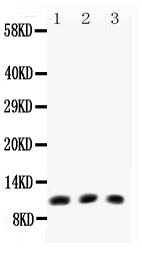Anti-Eotaxin Picoband Antibody
- SPECIFICATION
- CITATIONS
- PROTOCOLS
- BACKGROUND

Application
| WB |
|---|---|
| Primary Accession | P48298 |
| Host | Rabbit |
| Reactivity | Mouse |
| Clonality | Polyclonal |
| Format | Lyophilized |
| Description | Rabbit IgG polyclonal antibody for Eotaxin(CCL11) detection. Tested with WB in Mouse. |
| Reconstitution | Add 0.2ml of distilled water will yield a concentration of 500ug/ml. |
| Gene ID | 20292 |
|---|---|
| Other Names | Eotaxin, C-C motif chemokine 11, Eosinophil chemotactic protein, Small-inducible cytokine A11, Ccl11, Scya11 |
| Calculated MW | 10893 MW KDa |
| Application Details | Western blot, 0.1-0.5 µg/ml, Mouse |
| Subcellular Localization | Secreted. |
| Tissue Specificity | Expressed constitutively in the thymus. Expression inducible in the lung (type I alveolar epithelial cells), intestine, heart, spleen, kidney. |
| Protein Name | Eotaxin |
| Contents | Each vial contains 5mg BSA, 0.9mg NaCl, 0.2mg Na2HPO4, 0.05mg NaN3. |
| Immunogen | E.coli-derived mouse Eotaxin recombinant protein (Position: H24-P97). Mouse Eotaxin shares 62% and 97% amino acid (aa) sequences identity with human and rat Eotaxin, respectively. |
| Purification | Immunogen affinity purified. |
| Cross Reactivity | No cross reactivity with other proteins |
| Storage | At -20˚C for one year. After r˚Constitution, at 4˚C for one month. It˚Can also be aliquotted and stored frozen at -20˚C for a longer time.Avoid repeated freezing and thawing. |
| Name | Ccl11 |
|---|---|
| Synonyms | Scya11 |
| Function | In response to the presence of allergens, this protein directly promotes the accumulation of eosinophils (a prominent feature of allergic inflammatory reactions), but not lymphocytes, macrophages or neutrophils (PubMed:7568052, PubMed:8574847). Binds to CCR3 (By similarity). |
| Cellular Location | Secreted. |
| Tissue Location | Expressed constitutively in the thymus. Expression inducible in the lung (type I alveolar epithelial cells), intestine, heart, spleen, kidney. |

Thousands of laboratories across the world have published research that depended on the performance of antibodies from Abcepta to advance their research. Check out links to articles that cite our products in major peer-reviewed journals, organized by research category.
info@abcepta.com, and receive a free "I Love Antibodies" mug.
Provided below are standard protocols that you may find useful for product applications.
Background
CCL11, also known as Eotaxin, is a potent inducer of eosinophil chemotaxis and is considered as a selective ligand of the CC chemokine receptor 3(CCR3), which is expressed on eosinophils, basophils, and Th2 lymphocytes. The gene maps to chromosome 17 and is expressed constitutively at high levels in small intestine and colon, and at lower levels in various other tissues. CCL11 is a small cytokine belonging to the CC chemokine family. It is assumed to be involved in eosinophilic inflammatory diseases such as atopic dermatitis, allergic rhinitis, asthma and parasitic infections. The effects of CCL11 are mediated by its binding to a G-protein-linked receptor known as a chemokine receptor.
If you have used an Abcepta product and would like to share how it has performed, please click on the "Submit Review" button and provide the requested information. Our staff will examine and post your review and contact you if needed.
If you have any additional inquiries please email technical services at tech@abcepta.com.













 Foundational characteristics of cancer include proliferation, angiogenesis, migration, evasion of apoptosis, and cellular immortality. Find key markers for these cellular processes and antibodies to detect them.
Foundational characteristics of cancer include proliferation, angiogenesis, migration, evasion of apoptosis, and cellular immortality. Find key markers for these cellular processes and antibodies to detect them. The SUMOplot™ Analysis Program predicts and scores sumoylation sites in your protein. SUMOylation is a post-translational modification involved in various cellular processes, such as nuclear-cytosolic transport, transcriptional regulation, apoptosis, protein stability, response to stress, and progression through the cell cycle.
The SUMOplot™ Analysis Program predicts and scores sumoylation sites in your protein. SUMOylation is a post-translational modification involved in various cellular processes, such as nuclear-cytosolic transport, transcriptional regulation, apoptosis, protein stability, response to stress, and progression through the cell cycle. The Autophagy Receptor Motif Plotter predicts and scores autophagy receptor binding sites in your protein. Identifying proteins connected to this pathway is critical to understanding the role of autophagy in physiological as well as pathological processes such as development, differentiation, neurodegenerative diseases, stress, infection, and cancer.
The Autophagy Receptor Motif Plotter predicts and scores autophagy receptor binding sites in your protein. Identifying proteins connected to this pathway is critical to understanding the role of autophagy in physiological as well as pathological processes such as development, differentiation, neurodegenerative diseases, stress, infection, and cancer.


